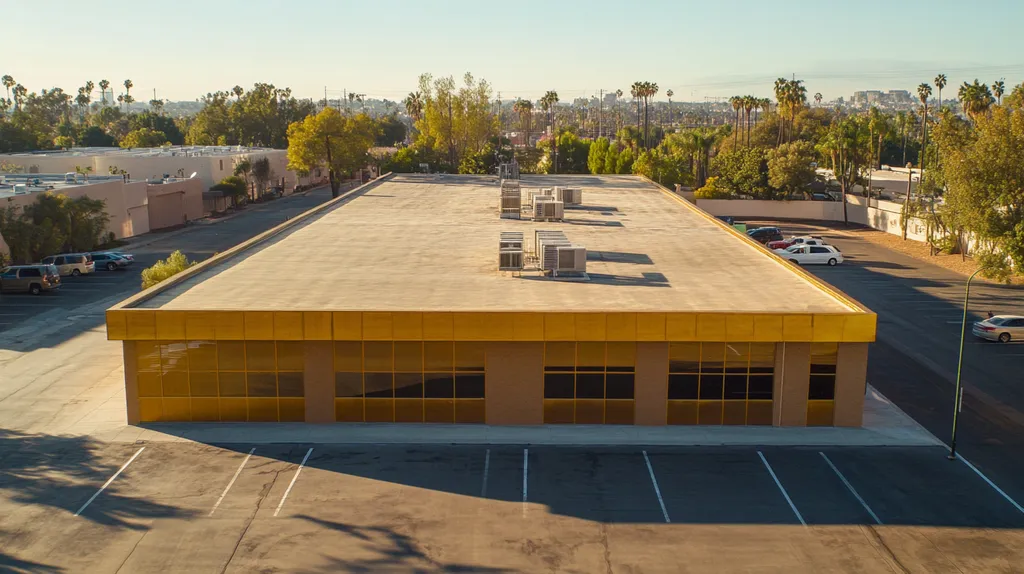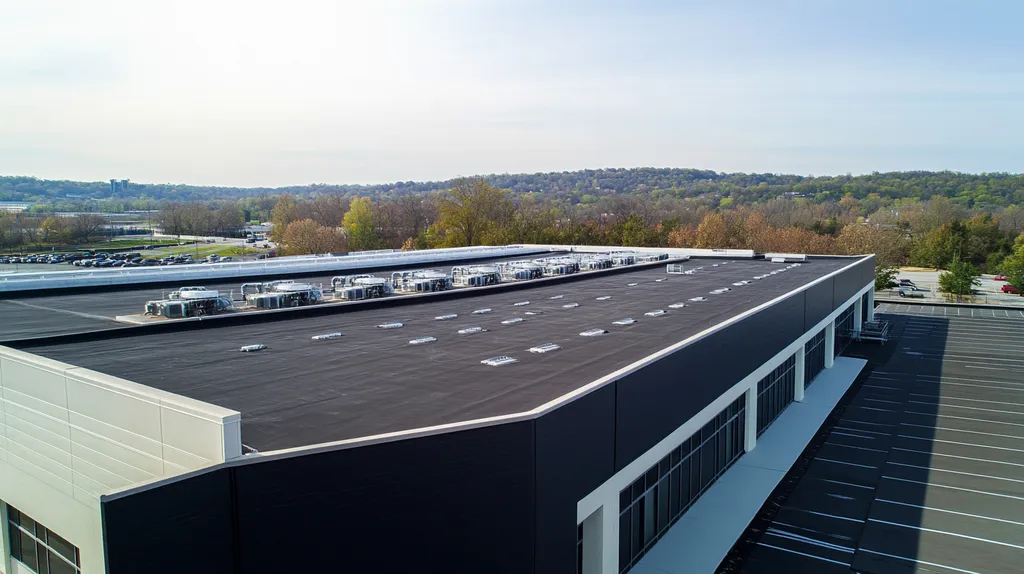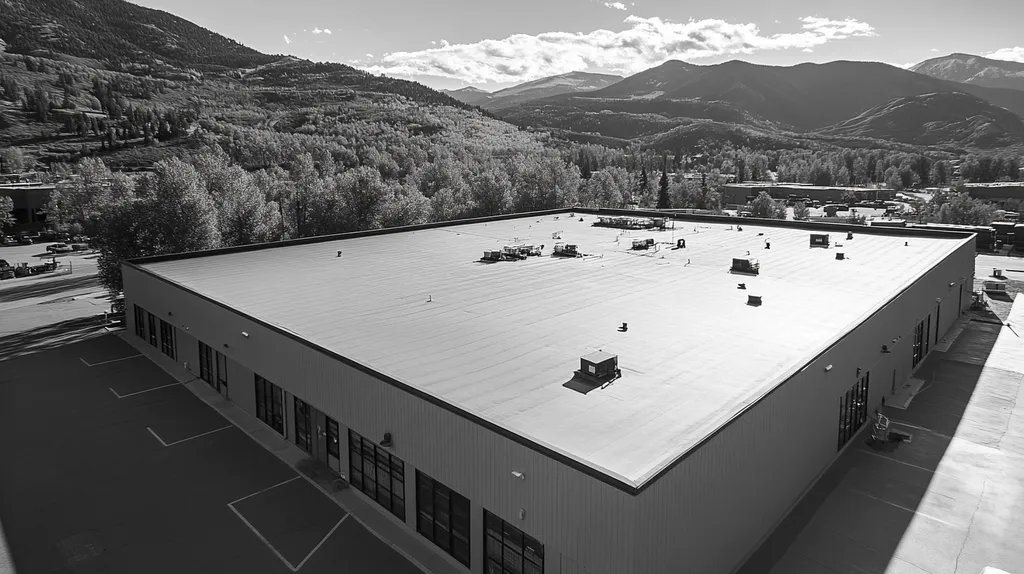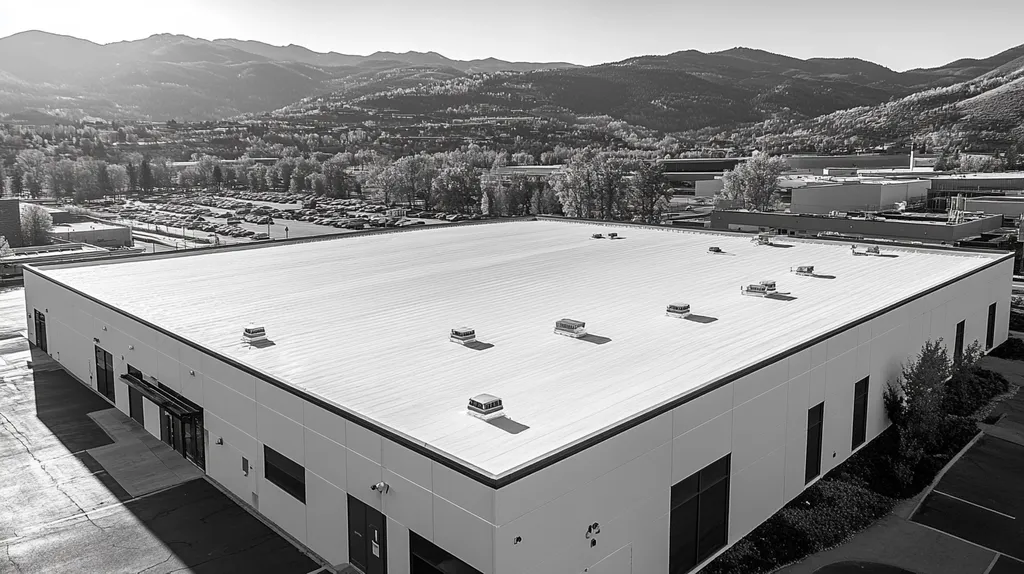Every year, industrial facilities waste millions on emergency roof repairs that could have been prevented with proper maintenance. Industry data shows that a well-maintained industrial roof can last 21-35 years, while neglected ones often fail in less than 10 years.
For facility managers and property owners, implementing a strategic roof maintenance plan isn’t just about preventing leaks – it’s about protecting valuable assets, ensuring operational continuity, and managing long-term costs effectively.
This comprehensive guide breaks down the essential components of industrial roof maintenance planning, from basic concepts to practical implementation strategies that extend roof life and reduce total ownership costs.
SECTION 1: THE BASICS EXPLAINED
Neglecting an industrial roof can turn an ordinary day into a financial nightmare. According to the National Roofing Contractors Association, ignoring routine maintenance can lead to dreaded leaks and structural breakdowns, costing businesses thousands each year. For property owners and facility managers who care about their bottom line and the longevity of their buildings, grasping the fundamentals of an industrial roof maintenance plan is non-negotiable.
What It Is (In Plain Language)
Think of an industrial roof maintenance plan as your roof’s personal trainer—it keeps it fit and functioning. This plan involves regular check-ups, maintenance undertakings, and essential repairs, customized for whatever roofing system you’re working with. It’s more than a bland checklist; it’s a comprehensive strategy aimed at catching smaller issues before they snowball into expensive disasters.
This approach acts as a map for navigating the roof’s care over time. By regularly scheduling inspections and tracking what the roof is telling you, building managers can spot potential trouble—everything from minor wear to serious structural problems that can grind operations to a halt.
Moreover, the maintenance plan should lay out specific responsibilities, inspection frequencies, and step-by-step procedures for different roofing elements. This kind of clarity ensures that crucial actions happen on schedule, significantly extending the roof’s usable life.
Ultimately, an industrial roof maintenance plan shifts the focus from knee-jerk reactions to a proactive mindset, creating a structured environment for ongoing roof care.
Why It Matters (To Your Building)
The significance of an industrial roof maintenance plan can’t be overstated; it’s a fundamental component of risk management for any building. At its core, a well-maintained roof shields valuable equipment, inventory, and personnel from the perils of water damage and other mishaps. In a commercial environment, a single water leak can bring production lines to a standstill, resulting in substantial financial losses.
In addition to protecting resources, a solid maintenance plan enhances a facility’s safety profile. Regular upkeep reduces the risk of accidents that stem from roof failures or falling debris. In sectors where safety is critical, like manufacturing and warehousing, these preventative safeguards couldn’t be more essential.
But there’s an added bonus: an effective maintenance plan can boost energy efficiency. By routinely checking for insulation problems or debris blocking drainage, facilities can lower those pesky energy bills. The result? Savings while inching closer to sustainability goals.
Investing in a roof maintenance plan isn’t just a quick fix—it’s a long-term strategy for stability and efficiency in industrial operations.
How It Works
The backbone of any industrial roof maintenance plan begins with a comprehensive initial inspection that assesses the existing condition of your roofing system. This process involves scrutinizing critical components like seams, flashings, and drainage systems for weaknesses. After the inspection, a detailed action plan emerges, which outlines necessary maintenance tasks and schedules for follow-ups.
But inspections aren’t solely about spotting leaks. They’re also an opportunity to catch early signs of wear, such as cracks or unwanted ponding water. Best practice suggests these should occur at least twice a year, ideally in spring and fall, prepping the roof for seasonal weather shifts.
Facility managers should also keep a meticulous record of all inspections and repairs. This documentation proves invaluable, serving as a roadmap for future maintenance and as essential evidence for warranty claims or potential buyers. A solid history of maintenance helps reduce risks linked to unforeseen emergencies.
Ultimately, the success of a maintenance plan hinges on how well it’s executed. Continuous education and open lines of communication among the maintenance team are key. Everyone needs to know their roles in keeping that roof in tip-top shape.
SECTION 2: PRACTICAL APPLICATIONS
When it comes to industrial roof maintenance, complacency is a luxury nobody can afford. Regular inspections and proactive maintenance can save businesses from the whirlwind of costly emergencies, which often lead to prolonged downtime. Alarmingly, nearly 30% of all building repair costs stem from neglected roofs. By implementing a structured maintenance plan, companies not only extend the life of their roofs but also enhance their overall facility performance. This section delves into practical applications of maintenance plans, the ideal times for them, and how they interact with other building systems.
Common Uses & Examples
Industrial roof maintenance plans aren’t just some vague concept; they are vital across various industries, each tailoring them to specific roofing needs. Take a manufacturing facility, for example, that schedules semi-annual inspections to catch leaks before they wreak havoc. Regular cleaning of debris is equally essential, especially for warehouses where leaves or snow can pile up and cause serious damage.
Consider thermographic inspections, which act like thermal sunglasses for roofs, spotting hidden moisture and temperature irregularities. These preventive measures ensure small issues don’t spiral into large headaches. Food processing facilities must maintain strict hygiene standards to keep contaminants at bay, necessitating ongoing checks of drainage systems and waterproofing membranes. Every proactive effort leads to long-term savings and operational efficiency.
When You Need It Most
Some situations demand heightened vigilance regarding roof maintenance. Seasonal transitions, particularly spring and fall, are prime time for inspections. During these months, roofs face threats like ice dams, heavy rainfall, and debris accumulation that can lead to severe damage if left unattended.
Extreme weather events, such as storms or hail, call for immediate inspection. What’s lurking beneath the surface after such events could turn into a financial nightmare down the road. Additionally, facilities undergoing major renovations should reassess their roofing needs. If a warehouse expands its operations, the roof might need reinforcements to accommodate new equipment or increased foot traffic.
Interactions With Other Systems
It’s crucial to remember that industrial roofing systems are not isolated entities; they work closely with other building systems. A compromised roof can lead to water intrusion, wreaking havoc on insulation and driving up energy costs due to ineffective heating or cooling. By establishing an integrated maintenance plan, businesses can ensure all systems operate in harmony, enhancing efficiency and reducing costs.
Coordination between roofing and drainage systems is equally essential. Regular maintenance ensures drainage pathways are clear, preventing water pooling that could lead to structural deterioration. This holistic approach not only protects the building but also minimizes maintenance costs associated with other systems. A thorough inspection of all components together creates a complete picture of the facility’s health, empowering managers to make informed decisions.
SECTION 3: KEY TERMINOLOGY DECODED
Mastering the language of industrial roofing isn’t just recommended; it’s essential. Misunderstanding key terms can lead to costly mistakes, from unforeseen repairs to premature roof failure. By familiarizing themselves with critical terminology, property owners and facility managers can make savvy decisions that extend roof lifespans and keep their budgets intact. This section will break down essential terms, clarify industry lingo, and simplify measurements, making roofing talk a breeze.
Essential Terms Explained
Industry Jargon Translated
Measurement & Units Simplified
SECTION 4: DECISION FACTORS
When it comes to industrial roof maintenance, every decision counts—one wrong move can lead to a cascade of costly repairs, bloated energy bills, and even serious safety concerns. Considering that routine maintenance can boost a roof’s lifespan by up to an astonishing 100%, understanding key decision factors like costs, performance trade-offs, and durability is absolutely essential. This section digs into those critical elements to empower property owners and facility managers in making smarter, more economical choices.
Cost Considerations
Cost is the pulse of any industrial roofing maintenance strategy. While investing in regular upkeep might seem like a budget-buster upfront, the truth is, it’s a money-saver in disguise. Research shows that preventative measures can slash emergency repair costs by up to 70%. Think about it—a little proactive maintenance now can prevent a Niagara Falls of expenses later.
When budgeting, it’s crucial to account for the potential financial fallout from downtime or unexpected repairs. A leaky roof isn’t just an inconvenience—it can grind operations to a halt, creating a domino effect of lost productivity and revenue. So, being proactive isn’t merely a strategy; it’s a survival tactic.
Also, don’t forget about warranties. Many roofing materials come with clauses that require specific maintenance to keep them valid. By adhering to these requirements, companies can minimize the financial impact of unforeseen failures. It’s all about striking the right balance between upfront costs and long-term savings.
Performance Trade-offs
Performance is the name of the game, and the choices made during maintenance play a pivotal role. Opting for cheaper, knee-jerk repair solutions might seem tempting for a quick fix, but in reality, it can lead to bigger headaches down the line. Facilities that invest in high-quality maintenance reap long-term benefits, proving that you often get what you pay for.
Different roofing systems each boast their own performance quirks and maintenance demands. A flat roof? It’ll have a different set of upkeep needs compared to its sloped counterpart. Understanding these distinctions is key to developing an effective maintenance strategy that not only keeps roofs intact but also extends their usability.
Implementing a routine inspection schedule allows facilities to spot minor issues before they grow into major problems. Regular maintenance not only enhances a roof’s structural integrity but helps keep energy efficiency high and indoor climates comfortable.
Lifespan & Durability Factors
The longevity and durability of an industrial roof hinge not just on the materials used but also on consistent upkeep. Data indicates that roofs with scheduled maintenance can last over 20 years on average—those without proper care often don’t make it to the finish line. It’s like the old saying: an ounce of prevention is worth a pound of cure.
Environmental conditions can also dramatically affect durability. Roofs that endure extreme weather need more frequent check-ups to address wear and tear. For instance, those in regions with heavy snowfall or harsh sunlight should have tailored maintenance plans to mitigate risks specific to their climate.
Choosing the right materials is pivotal for boosting durability. Thermoplastic roofing systems, for example, stand up better against UV rays and chemicals, ensuring a longer life when cared for properly. Regular inspections can spotlight vulnerabilities and help avoid costly catastrophes.
In conclusion, a solid grasp of lifespan and durability factors helps property owners make informed decisions for their roofing investments. Proactive maintenance isn’t just smart; it’s essential for ensuring roofs fulfill their intended lifespan effectively.
SECTION 5: COMMON CHALLENGES
Managing an industrial roof can feel like juggling chainsaws: one misstep and the results can be catastrophic. Research indicates that a staggering 30% of roofing failures stem from inadequate maintenance. For facility managers and property owners, being proactive isn’t just helpful; it’s essential for extending the roof’s life and protecting your financial investment. This section dives into frequent issues, warning signs to keep an eye out for, and effective preventative strategies to reduce risks.
Frequent Problems & Solutions
Water damage tops the list of common roofing challenges, often resulting from neglected leaks. Unaddressed leaks can snowball into serious structural issues, like mold growth and damaged insulation. Regular inspections and quick fixes can catch small leaks before they wreak havoc on your bottom line.
Debris accumulation is another prevalent issue. Leaves, dirt, and other materials can clog drainage systems, causing water to pool and increasing wear on the roof. Establishing a routine cleaning schedule ensures that drains and gutters are clear, significantly reducing the odds of water damage.
Punctures and tears from both weather events and foot traffic can also compromise a roof’s integrity. These breaches pose serious leakage risks if not sealed swiftly and properly. Addressing punctures as they occur with suitable roofing materials can drastically extend the roof’s lifespan.
Additionally, prolonged UV exposure can degrade roof materials, leading to premature replacement if not regularly monitored. To counteract this, applying UV-resistant coatings can help preserve essential protective features and prolong life.
Warning Signs To Watch For
Facility managers must remain vigilant for warning signs that scream “roof trouble!” Stained ceilings or walls typically indicate urgent leaks that must be addressed immediately. Ignoring these clues can escalate into significant water damage and even mold growth.
Visible blistering or bubbling on the roof’s surface is a dead giveaway that moisture has become trapped beneath the materials. This warrants immediate inspection to prevent further deterioration. Early detection here can save significant hassle and costs later.
Unusual sagging areas can be the precursor to catastrophic structural failure. These areas might indicate water pooling or compromised underlayment. When this happens, a professional assessment is crucial to determine the right course of action.
An uptick in energy bills can suggest insulation problems or inefficiencies in roof performance. Poor insulation results in heated air escaping, leading to inflated utility costs. Conducting a comprehensive energy audit can help pinpoint what’s amiss.
Preventative Approaches
Establishing a solid preventative maintenance plan is crucial for tackling common roofing challenges head-on. Implementing a schedule for inspections at least twice a year will facilitate early detection of potential issues. Each inspection should involve a thorough examination of key areas like seams, flashings, and penetrations.
Creating a cleaning schedule to minimize debris buildup is equally important. Regularly removing leaves, branches, and other obstructions—whether weekly or monthly—ensures efficient drainage and reduces unnecessary wear on roofing materials.
Investing in high-quality roofing materials designed for environmental durability is a smart preventative strategy. Such materials can resist harsh weather and UV rays, leading to a longer roof life when well maintained.
Finally, putting an emphasis on employee training for safe roof access can substantially decrease accidental damage during maintenance. Teaching the workforce about careful movement and proper equipment usage can keep that roof in excellent condition for years to come.
SECTION 6: NEXT STEPS & RESOURCES
The stakes are high when it comes to industrial roof maintenance. Ignoring routine upkeep can escalate repair costs by up to 50%, turning manageable issues into financial disasters. For property owners and facility managers, taking decisive action on maintenance strategies is not just advisable; it’s essential. This section explores critical questions to pose to roofing contractors, essential industry standards, and resources for further learning.
Questions To Ask Providers
Before engaging a roofing provider, asking the right questions can be the difference between a solid partnership and a costly mistake. Start by inquiring about their specific experience with industrial roofing systems. References are key; seek examples that demonstrate their capability to handle projects of similar size and complexity while meeting timelines.
Dig into their maintenance plan philosophy. Understanding their methods of assessing roof health and the recommended inspection frequency is crucial. It’s equally important to clarify warranty details and ensure you know what’s covered and for how long.
Finally, probe into their emergency response procedures. Knowing how quickly and effectively they respond to urgent issues can save you from extended damage, operational disruptions, and hefty repair bills. Prompt communication and transparency can greatly enhance your roof’s upkeep experience.
Industry Standards & Guidelines
Being aware of industry standards can guide property owners towards effective maintenance practices. The National Roofing Contractors Association (NRCA) sets forth guidelines that represent the gold standard for roofing care. Adhering to these guidelines helps prevent common pitfalls and can significantly increase your roof’s lifespan.
Additionally, the American Society for Testing and Materials (ASTM) has established protocols for conducting roof inspections and assessments. These standards specify best practices for evaluating roof performance, ensuring you’re making informed decisions.
Don’t overlook local building codes and regulations. Compliance with these rules not only safeguards operational safety but also shields you from potential legal entanglements and financial repercussions. Regular training and workshops offered through industry associations can help keep you in the know.
Further Learning Simplified
For those eager to expand their knowledge on industrial roof maintenance, abundant resources are at your fingertips. Online platforms offer courses and webinars specifically designed for property owners and facility managers, providing valuable insights and tips.
Stay connected with industry publications and blogs that delve into emerging trends and best practices. Subscribing to reliable sources ensures that you remain informed within this fast-paced sector.
Lastly, getting involved in local and national roofing associations opens the door to networking opportunities and a wealth of resources. Engaging with these communities not only aids in professional growth but also promotes the exchange of knowledge and practices that can benefit all stakeholders involved.
The Bottom Line
With industrial roofing costs skyrocketing 30% in the last five years, implementing a strategic maintenance plan isn’t optional—it’s imperative for survival.
The data is clear: properly maintained industrial roofs last 21-35 years, while neglected ones often fail within a decade, leading to catastrophic repair costs and operational disruptions.
Smart facility managers are moving beyond reactive maintenance to embrace comprehensive, proactive programs that include bi-annual inspections, detailed documentation, and systematic preventive care.
The future of industrial roofing lies not in flashy new materials or AI-powered sensors, but in the disciplined execution of proven maintenance strategies that maximize ROI and minimize unexpected failures.
The choice is simple: invest in maintenance now, or pay exponentially more later.
FREQUENTLY ASKED QUESTIONS
Q. What is an industrial roof maintenance plan?
A. Think of it as your roof’s personal trainer—regular inspections and targeted maintenance tasks to keep it fit and functional. This strategic plan helps identify small issues before they escalate into costly disasters, ensuring your roof lasts longer and protects your facility.
Q. When do I need to schedule inspections for my commercial roof?
A. Schedule inspections at least twice a year, ideally during spring and fall. These key times catch seasonal threats like heavy rain or ice build-up, ensuring your roof is in top shape before extreme weather strikes.
Q. What common problems should I watch for on my industrial roof?
A. Keep an eye out for water damage, debris accumulation, and visible wear like punctures. Early detection of these issues can save you from major repairs and operational disruptions down the line.
Q. What costs should I consider for my industrial roof maintenance?
A. Although upfront maintenance costs might sting, consider them an investment. Preventative upkeep can cut emergency repair costs significantly, delivering long-term savings by avoiding future catastrophic failures.
Q. How does roof maintenance affect energy efficiency?
A. Regular maintenance can identify insulation issues and debris clogging drainage, significantly enhancing energy efficiency. A well-maintained roof minimizes energy bills and fosters a stable indoor climate for your operations.
Q. What questions should I ask a roofing contractor?
A. Inquire about their experience with your specific roofing system and details on their maintenance plans. Understanding their emergency response times and warranty coverage can also help ensure you choose a reliable partner.
Q. How can I learn more about industrial roof maintenance?
A. Dive into online courses, webinars, and industry publications. Connecting with local associations and networking can further expand your knowledge while providing valuable resources to enhance your facility’s maintenance strategy.











